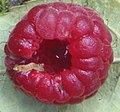A | B | C | D | E | F | G | H | CH | I | J | K | L | M | N | O | P | Q | R | S | T | U | V | W | X | Y | Z | 0 | 1 | 2 | 3 | 4 | 5 | 6 | 7 | 8 | 9
The term compound fruit is not used in technical botanical writing, but is sometimes used when it is not clear which of several fruit types is involved. A compound fruit is "composed of two or more similar parts".[1]
A compound fruit may be:
- An aggregate fruit, in which one flower contains several separate ovaries, which merge during development.
- A multiple fruit, in which several flowers, each with an ovary, develop into small fruits that are clustered or fused together into a larger fruit.
- A simple fruit formed from a compound ovary.
-
A raspberry is an aggregate fruit (shown with a raspberry beetle larva)
-
A pineapple is a multiple fruit
-
A tomato is a simple fruit derived from a compound ovary
Grapes grow in clusters, but are not compound fruits. Each grape is grown from one ovary in one flower, and each grape remains an independent fruit.
References
- ^ Hickey, M.; King, C. (2001). The Cambridge Illustrated Glossary of Botanical Terms. Cambridge University Press.
>Text je dostupný pod licencí Creative Commons Uveďte autora – Zachovejte licenci, případně za dalších podmínek. Podrobnosti naleznete na stránce Podmínky užití.
Text je dostupný za podmienok Creative
Commons Attribution/Share-Alike License 3.0 Unported; prípadne za ďalších
podmienok.
Podrobnejšie informácie nájdete na stránke Podmienky
použitia.




